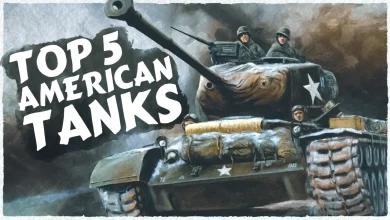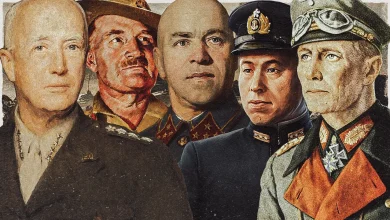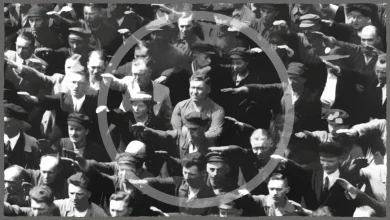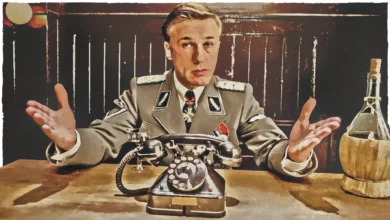The Liberation of Dachau Concentration Camp
At the end of April 1945, in the Dachau concentration camp near Munich, over 30,000 people were barely clinging to life and the brutal SS guards. Time was fast running out for the prisoners as the war situation continued to deteriorate for Germany. The action had to be taken and taken fast, but who would take that action?

On the 25th of April 1945, Germany had been cut in two when American and Soviet troops linked up at the town of Torgau on the Elbe River. The following day U.S. Forces had crossed the Danube, Neuburg, Ingolstadt and Kelheim. Dachau concentration camp was severely overcrowded due to the Nazi policy of evacuating West inmates from camps in danger of being overrun by the Red Army.
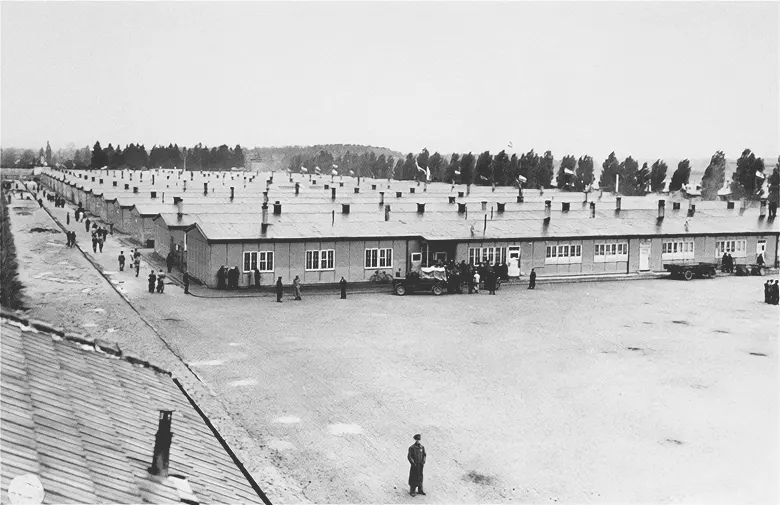
The Commandant SS-Obersturmbannführer Eduard Weiter had written to Heinrich Himmler requesting permission to turn the camp over to the Americans.

Himmler had angrily written back forbidding any such action. He added at the end of his letter: “No prisoners shall be allowed to fall into the hands of the enemy alive.” The prisoners at Dachau were ordered to be evacuated south into the Tyrolean Alps as part of German preparations for the Alpine Redoubt, their semi-mythical last stand in the mountains. The SS were also busily burning files and documents at the camp in the hope of covering their tracks.
Dachau was the very first concentration camp, that opened shortly after Hitler came to power in 1933. It held political prisoners, Jews, ordinary German and Austrian criminals, and foreign nationals of almost all of the countries attacked by Germany.

The installation spawned over 100 subcamps to house prisoners being used for forced labor. Well over 30,000 people died at Dachau including many who perished in a program of medical experimentation by SS doctors. Commandant Weiter made efforts to follow Himmler’s evacuation order. On the 26th of April, Weiter, most of his officers, and a strong guard detail left Dachau, escorting a death march consisting of six to seven thousand inmates to Tegernsee.

During the six-day march, thousands were executed or died of exhaustion, hunger, and exposure. One mass grave was later found to contain 1071 bodies. Weiter then made himself scarce, going on the run in the Austrian mountains. SS-Untersturmführer Heinrich Wicker, an extremely junior officer, was left in command at Dachau with about a hundred and fifty guards.

There were still tens of thousands of starving prisoners inside the camp and the supply situation had by now completely broken down. Adjacent to the camp was several hundred Waffen-SS troops who would probably be used to exterminate the surviving prisoners at an appointed moment. Meanwhile, the Americans were fast approaching nearby Munich, the cradle of Nazism. The situation at the concentration camp was confused. Since the Commandant Weiter, the officers and most of the guards had absconded on the 26th of April, escorting a large party of prisoners south.

The tall scar-faced SS-Untersturmführer Wicker had been left in charge. Though only a very junior officer Wicker had come up through the ranks, he was an experienced and decorated combat veteran. Due to wounds received in battle, he had been assigned to concentration camps. There were still over 30,000 prisoners inside the camp, and the food and water had run out some days previously. Wicker’s orders were unclear, he knew that Himmler did not want the camp surrendered, but he lacked the manpower to kill all the prisoners. And so Wicker awaited orders that did not come.
On the 29th of April, Red Cross official Victor Maurer convinced Wicker not to attempt to evacuate the camp which would have killed thousands, and instead to surrender the facility and its inmates to the Americans. Maurer promised that if Wicker did this, then he and his men would be allowed to flee unmolested. Of course, the Americans had no idea of this agreement. The Americans did however have some inkling of the possible horrors that they would find the Dachau from an escaped inmate. On the 28th of April, Karl Riemer had managed to get out of the camp and walk through the night to the town of Pfaffenhofen. U.S. forces had already reached the settlement and Reimer briefed them about the conditions of the camp and the desperate plight of the remaining prisoners.

Lieutenant-Colonel Felix Sparks commanding officer of the 3rd Battalion, 157th Infantry Regiment, 45th Infantry Division was ordered to relieve Dachau. He wasn’t impressed by the job, considering the camp to be a non-military target. At 9:22 on the morning of the 29th of April, Sparks received a message from the 157th Infantry’s S-3 intelligence officer, sent to all companies that upon the capture of Dachau they would oppose guards around the camp and touch nothing and also ensure that no one left the compound. Sparks commanded a small task force consisting of his own battalion from the 157th Infantry and the 191st Tank Battalion. He split the task force into two prongs advancing on parallel roads towards Dachau. The first column under his personal command, the second and a Major George Kessler.
The problem for the Americans was at units from two of its infantry divisions were converging on Dachau. Sparks’ 157th Infantry from the 45th Division would arrive around the same time as elements of the two 22nd Infantry Regiment, 42nd Infantry Division creating severe jurisdictional confrontations.
At 10:00 a.m. Lieutenant Colonel Donald Downard commanding the 2nd Battalion, 222nd Infantry reported a skirmish at a roadblock near the camp and captured several Germans. An hour later, Colonel Sparks’ men also had a brief firefight with retreating German forces. At noon, inmates inside the camp saw American soldiers for the first time, outside the perimeter, they rushed cheering and crying towards the perimeter fences with the SS opened fire shooting down one man. 15 minutes later, Sparks briefly conferred with Lieutenant William Walsh commanding Company I, 157th Infantry ordering him to secure the camp and to keep the prisoners inside. “Don’t let them out!” ordered Sparks, “We’ve got all kinds of food, medicine, and what have you coming in behind us and we’re going to take good care of them”. Sparks ordered Company M’s machine gun platoon to accompany Company I, simultaneously Sparks sent Company L to secure Dachau town.
Well though Sparks did not know it, Wicker and many Germans had gathered unarmed at the camp’s main gate awaiting the arrival of the Americans. Fearing heavy resistance, Sparks ordered Company I to advance up the railway line to the spur instead of through the main gate. On the railway line Company I discovered an abandoned engineless train.

They counted 39 wooden wagons, sprawled on the track and around the fields bordering the line were many bodies, most showing signs of gunshot wounds. When the GIs hauled open one of the wagon doors they were dumbfounded by what they discovered. It was eventually established that there were 2,310 bodies of men, women, and children on or near the train, some naked, some wearing striped concentration camp uniforms.

They were all severely thin, and many appeared to have died of starvation or thirst inside the locked carriages, callously left to die by the fleeing SS while others showed evidence of execution by gunfire.

The GIs were furious, many also sought immediate vengeance on any Germans that they managed to capture. Shortly afterward, Company I commanding officer Lieutenant Walsh shot 4 surrendering SS inside a wooden railway wagon. Private Albert Pruitt then climbed inside and finished off each of the Germans with a shot to the head.

Walsh’s men took Colonel Sparks to see the SS dog kennels where the Germans kept Alsatian guard dogs. Most of the animals were already lying in pools of blood after enraged GIs shot dead 25 to 30 of them.

While Sparks and his men from the 45th Infantry Division move deeper into the camp. Units from the U.S. 42nd Infantry Division began entering Dachau town at 1:00 p.m. The Assistant Divisional Commander Brigadier General Henning Linden quickly put together a small task force in five jeeps. Led by Linden, the group also included Brigadier-General Charles Banfill Deputy Commander Operations U.S. 8th Army Air Force, several staff officers, and a handful of war correspondents and photographers. Linden’s group raced off to the camp’s main entrance by way of the abandoned train and its gruesome human cargo. After ducking from the burst of incoming small arms fire Linden’s party dismounted from their jeeps and cautiously approached the gatehouse, its large wooden gates topped with a huge Nazi eagle and swastika.

SS-Untersturmführer Heinrich Wicker accompanied by an unarmed aide and Red Cross representative Victor Maurer went out to meet Linden’s party. They found General Linden and his soldiers in a very dark frame of mind. Linden actually struck Wicker with a swagger stick that he carried British style, forcing the German officer to raise his hands. On Linden’s order Wicker was taken to see the evidence, shortly after the last Commandant of Dachau was killed in mysterious circumstances.

Subsequent investigations suggest that inmates used the rifle of a young American GI to execute Wicker and his aide. A court-martial of this private first class was begun but later abandoned. Wicker although an SS officer and a concentration camp veteran had nonetheless stayed behind to surrender the camp to the Americans and should have been treated as a prisoner of war. But the atmosphere on that day of liberation was very ugly as U.S. troops confronted what men from Wicker’s arm of service had done to the prisoners at Dachau.

Troops from Company H, 222nd Infantry Regiment caught up with General Linden’s party before the main gate, by now a huge mob of prisoners cheering hysterically surged towards the American soldiers. 25-year old war correspondent Marguerite Higgins wanted to enter the camp and get a big scoop, the liberation of Dachau. The Colonel Sparks and men from the 157th Infantry Regiment arrived. Arguments between the officers of the two competing divisions broke out against the backdrop of the cheering prisoners. Sparks categorically refused to permit Higgins entry to the camp as per his orders. Linden outranking Sparks attempted to overrule him but Higgins managed to get inside only to be mobbed and nearly trampled to death by hundreds of inmates. Soldiers from the 222nd and 157th Infantry both fired their weapons into the air to disperse the out-of-control inmates and rescue Higgins. It appears that General Linden took offense at one of Sparks soldiers who was swinging from a bottle and wrapped him on the helmet with his swagger stick. Sparks in an outrageous display of gross insubordination, perhaps fueled by the grim and emotional sights in the camp, drew his Colt 45 pistol and leveled it at General Linden saying: “If you don’t get the f… out of here, I’m going to blow your brains out!” another version of this story has Sparks yell: “If you ever touch one of my men again I’ll kill you!” either way the two men almost came to blows before Lieutenant Colonel Walter Fellenz on Linden staff jumped between them. But a fresh confrontation developed between Sparks and Fellenz. “I’ll see you after the war” threatened Fellenz “You son of a b…” yelled back Sparks “What’s the matter with right now?”. Fortunately, Linden’s group left before things became any worse, in the meantime, troops from both the 222nd and 157th Infantry Regiments entered the camp.

One unit machine gun to death 16 SS where their hands raised in a coal yard. They were part of a larger group that included Wehrmacht troops from the nearby hospital captured by Company I, 157th Regiment.
Company I Executive Officer Lieutenant Jack Bushyhead, a Sioux Native American, segregated the SS from the other prisoners and marched them into the coal yard. The young GI manning the machine gun shouted that the prisoners were trying to run away and open fire. An officer kicked the teenager away from the weapon that he and his squad have managed to kill or wound many of the prisoners.

Between 25 and 50 SS and prisoner kapos were summarily dispatched by enraged prisoners, the American soldiers standing back and watching. In some cases, GIs handed the prisoners weapons. Her further 17 SS were executed outside guard tower B while many more were shot by sickened American troops, horrified, and deeply traumatized by the piles of rotting skeletal bodies that lay unburied throughout the facility.

Eventually, their officers brought U.S. troops under control, an order was restored. Though understandable, the American reprisals constituted a war crime, a potentially deeply embarrassing situation for the Allies. There was serious talk for a time of bringing some officers before courts-martial. However, General George S. Patton the newly appointed Military Governor of Bavaria dismissed all charges. For many of the perpetrators of the horrors of Dachau, death caught up with them soon enough. The former Commandant of Dachau Eduard Weiter tried to hide out in the Austrian mountains. Ironically he was probably murdered at Itter by a fellow SS officer on the 2nd of May 1945.

For the Americans there now began the long and difficult task of trying to save as many lives as possible amongst the emaciated and diseased prisoners at Dachau.
